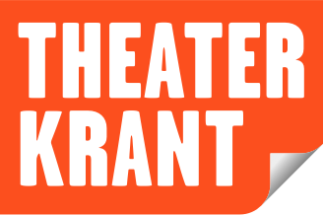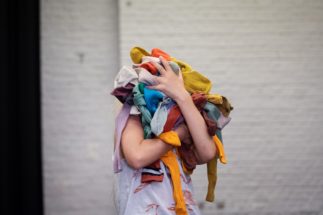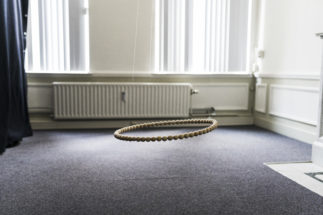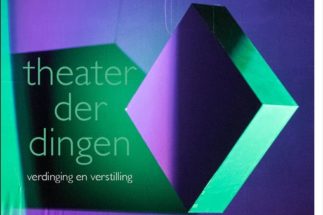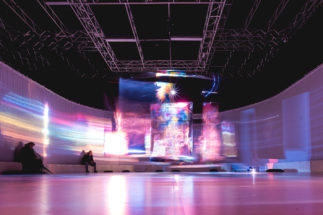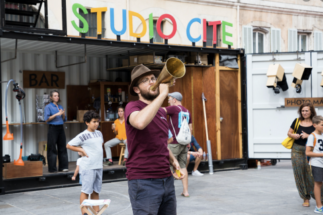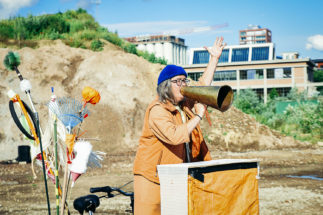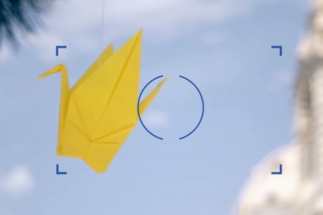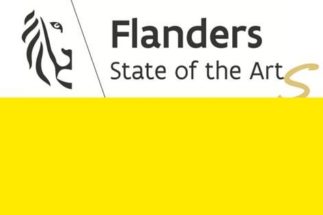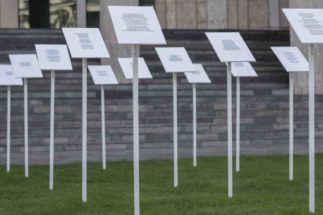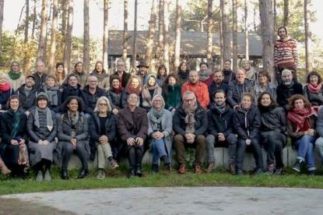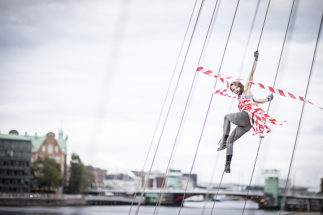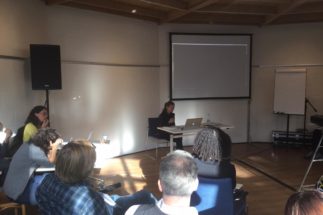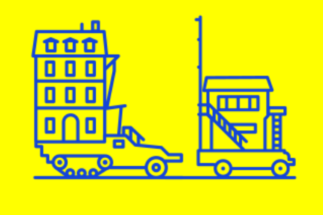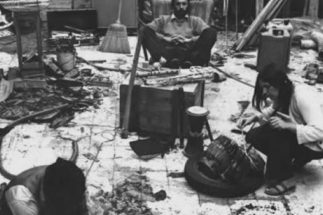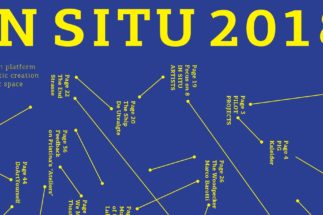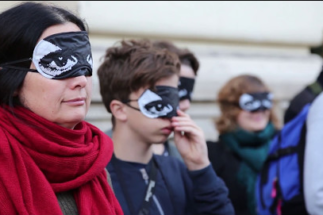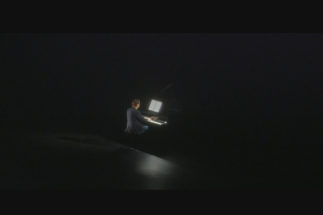Trans-, un- or pan-disciplinarity
06.04.2018
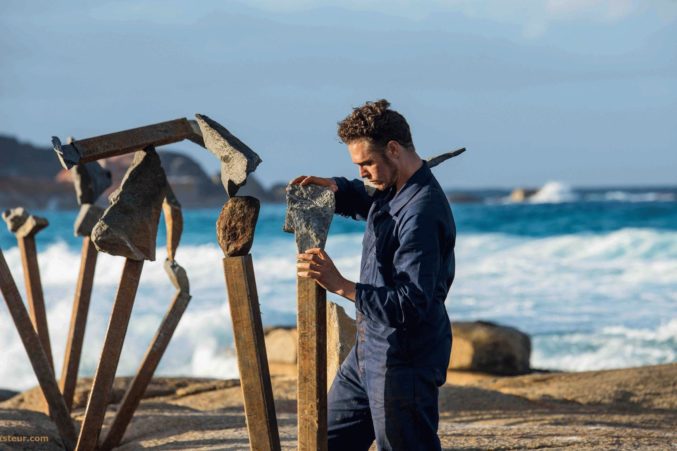
This recent tendency in contemporary art, what does it imply?
On a central square in the city of Hasselt, two rocks are being placed on top of each other. The upper one grates the surface of the lower one, trying to find the right spot where they stand in perfect balance. Artist Nick Steur is the one who controls the lever that is turning the rocks into place, with a motion that combines the elegance of a dancer and the force of an Egyptian slave, pushing stones to the top of the pyramid. The way he moves, hypnotizes the public that circled around him to figure out what he was doing, but in the meanwhile stopped breathing and just watches silently.
A couple of hours later, the two stones seem to balance effortlessly on top of each other. But just for a second. Steur only needs one move to bring them out of equilibration and make them crash on the pavement. The spectators, who only started to breathe again just now, look bewildered. What did they just see: a performance? A dance? A statue in the making? And if so, where is it right now? “It’s a typical example of transdisciplinary art”, theoreticians would say. But that’s a difficult term as well to comprehend as a spectator and non-theoretician. And even if you could truly understand the meaning of that word: would it learn you anything more about the piece of art you are looking at?
It is a common reflex to look for a grip on things, for something familiar in the chaos that is life. Categorizing a phenomenon and acknowledging what just happened brings peace and solace to the spectator. He or she can now compare the newly acquired information with the info they already had, and compare the two groups to label what he witnessed as ‘similar to’ or ‘different from’ what he had already seen before. When this act of categorizing does not apply immediately to the event, he will feel triggered or a little confused at best, but scared and frustrated in the worst case scenario. Transdisciplinary art causes that kind of trouble. Although the spectator has seen Steur’s process, he was not sure what he just saw. It was impossible to link it with something similar he had seen before, though at the same time it reminded him of so many things: performances, dances, sculptures, …
Catego-mania
That eager to find familiar characteristics when confronted with a new experience, is definitely true for art historians. The ancien régime-need to teach students ‘what art (good) art is’, lead to generations of students that just repeated or revised what was taught to them by their teachers. Only an occasional artist took pride in ‘thinking out of the box’ and tried to challenge or change what was common art back then, when – compared to what we know now – he only dared to search for new possibilities 0,5mm further than the lines that were drawn for him/her by his predecessors.
This caution towards what ‘should be’ and what really shouldn’t be considered art, resulted in a typically Western idea of ‘disciplines’: fine arts, film and photography, architecture, theater, literature, music and dance, … Though the spectator may not sense the importance of this need for categories, judging or describing an object is directly associated with language. And that what cannot be put into words accurately, will be also much harder to judge or speak of in a more profound way.
But what if art stretches beyond these borders of what is comprehensible for the audience with the knowledge they possess at the moment? The In Situ Insight seminar (Hasselt, 2016), that also starred other transdisciplinary artists, was yet another prove that trying to categorize the art world of 2016 is an old-fashioned and dated tic we cannot manage to unteach ourselves. Or at least this is the case for categorizing as we know it!
Very often, the organization criteria to put pieces of art into coherent groups, are based on the art discipline from which they arose. That is a problematic way of handling things, when it comes to conceptual art, where the choice of materials and the discipline in which the artist works is less determinative for the end result than the idea that lies behind it. The result of this dated way of working are bulky category names like ‘performance-art’ or ‘installation piece’, that are not completely separable from sister-categories as respectively dance and theater or sculptures. That makes the word ‘category’, that inherently stresses the ability to separate one thing from another, misleading since it is still a vague description of all art included. But even more than for a better and more comprehensive category, we have to look for a new way of categorizing in order to apprehend the true meaning of the word ‘transdisciplinary’.
The common elements in the subsets
A technique that might be similar for the one we will be needing to do so, was handed to art historians on a silver platter almost a 100 years ago but truly understated. Theoretician and compulsive accumulator Aby Warburg organized his large collection of pictures and drawings of art not only by discipline, but also by depicted theme, used symbols or colors as well as his personal thoughts on the piece. He called it the ‘Bilderatlas’: a giant network of interconnected and linked objects, affected with arts or culture in general. Though dismissed as ‘incomplete’ or ‘germinated from a chaotic brain’, his influence triggered the founding of the study of Iconology and the start of multidisciplinary research in Art History – a way of studying things that transdisciplinary art would surely benefit of.
Trying to define transdisciplinary art, says Linda DiPietro, speaker at In Situ Insights, is not searching for a discipline that fits the artwork best, but looking at art in a Warburgian way and dissecting the work into all the fragments that make the piece what it is. So not just take a look at the discipline but also the use of materials, the idea behind it, the techniques used, the way it affects the public, … as well as the reason why the artist made all these choices. She said transdisciplinary art does not hover between two disciplines (as the word implies) but is in fact undisciplined. She strips the term of its negative connotation and says it only means the artist tries to get free from the discipline, tries to choose for chaos and uncertainty, and tries to start a project with a clear head and no preliminary ideas of what the project has to become. The power and self-assurance the artist has to possess to make such bold choices, are based on what she calls the ‘myriad of possibilities’: “Human beings are the only species that are literally capable of almost anything. Then why choose to specialize in something and forget all the other possibilities we have?”
But although DiPietra rejects the oppressive use of strict categorizing and naming, transdisciplinary art – for her – is not a series of vague pieces of art, floating around in an insignificant void without being interconnected or having some similarities. She speaks of vagueing borders, as there is the one between intimacy and spectacle, as well as the tendency of the artists to outsource authorship. Both characteristics of this new way of perceiving art are closely linked to one another. To prove that point she mentions the Grossetête project Structures Monumentales (2015), where a large group of people create a disposable replica of the historic building on a square in their hometown Terni.
The artist is not the one building (outsourcing authorship), that would be the public, and although the process of building looks like a phase in between ‘empty square’ and ‘finished art piece’, that does not appear to be the case when the building is torn down after being finished. It is only in that exact moment that the spectator gets the second characteristic: the production process and the orchestrated way in which the people worked together were the real piece of art, not the carton building standing in front of them. The individual (wo)men that decided to take part in the process were at the same time spectators and an artists, what illustrates Di Pietra saying the border in between intimacy and spectacle is fading. People who were used to only witnessing what artists created for them, are not able to define their exact role in the process anymore.
Although the characteristics she names are very profound ones, her list is not completely comprehensive. They point at the vagueing of borders and the exploring of the grey areas in between, but when doing so, only mention a few of those. In the exact same way as ‘maintaining authorship’ or ‘protecting the artist’s intimacy’ seemed crucial before, but not anymore for transdisciplinary art, the opposite appears to be true as well. When looking at what guest lecturers/artists considered very important for the way in which they create, factors come op that seem trivial at first: time, location, movement and sound and the object-fetishism.
Looking back at Steur’s A Piece of 2, it was complete control of the human body and the laws of physics, but also timing that made the two rocks balance on top of each other. Location was mentioned in the guest lecture he gave himself, where he states that it is a room or a place that inspires him to make art. “If I start creating with a clear vision in my head of what I am going to do, it does not work. Although I never start without an idea for a project, I am still open for byroads that seem more interesting.” But if it is the room that inspires the artist, that means the work of art is only able to be exposed in a limited amount of places. Movement, the third element, was a very prominent factor for the work of guest lecturer Cocky Eek and collective Schweigman&. While Steur’s work seems to be a combination of performance, dance and sculpting, Eek’s balances between installation art and sculpting, adding dance and soundscapes. Movement is crucial in the way she makes her inflatable sculptures move as well as when she lets the spectators enter the installation. They might feel desoriënted of as if they entered another world: a feeling that is completely caused by a perfect control of movement, light and sound. Object-fetishism is the last mentioned in the list but maybe the most eye cathing one. The declining importance of an object as a proof the art is finished, or the uncertainty of further existence when it comes to a temporary piece, are crucial into describing and understanding transdisciplinary art. This is proved by pushing over as well A Piece of 2 and Structures Monumentales. After so much work and time spent, it all ‘seemed’ useless, like making a mandala in the sand. But the beauty and the art was in de process of working, the movement, the implicit roles of power and subordination in the Terni project, … and not in the object an sich. All of these elements, that are more or less additional factors for a painting or a statue (which museum shows the painting, when the painting was made or looked at, …), are the foundations of transdisciplinary art.
Multidisciplinarity
Looking at these characteristics, one could moot that transdisciplinary art coincides with ‘contemporary conceptual art’. Both revolve around a person with a head full of ‘ideas’ that need to be extraverted in a way. The way in which the artist knows or prefers discipline that will be used, is thereby subordinate to the needs of the ‘idea’ that wants to be brought to life. This would mean, in retrospect, that Rembrandt wouldn’t just paint a portrait cause he is a brilliant painter.
As a transdisciplinary artist he would look for a way to depict the personality of the model as comprehensive and true as possible. This could lead to the combination of a perfumed statue in a room where suitable music is playing. More facets of the depicted are included than if it were just a painting or just a statue without the visuals. The artist does no longer think of him- or herself as really good in one or other discipline, but more as a idea-maker.
But the term ‘conceptual art’ is problematic because of its huge- and vagueness. When categorization appeared to be impossible, a restgroup was established and based on the fact that in all the pieces included, the idea prevails over the purely visual appearance of the end product. But the subdivisions theoreticians tried to establish in the meantime are problematic, since they pushed the art once again in tiny category-boxes. A work of art was a performance piece, or an installation, or experimental theatre, … This , when pieces like Steur’s A Piece of 2, clearly prove that the different ways of creating are no longer strictly distinguishable.
Solving that problem of insufficient category (names) and further exploring the differences between the term ‘conceptual art’ and ‘transdisciplinary art’, it’s also questionable whether transdisciplinary art is, as Di Pietra said, in a moment of transition, balancing between the past genres of art and breaking free. Cause isn’t it also possible that transdisciplinary art is in fact a renewed and less polished version of conceptual art – a version where people just combine techniques and disciplines however and whenever they feel like it. With that idea in mind, we have to look back at Di Pietra’s statement that transdisciplinary art is undisciplined. Another possibility that can be put forward here is that, instead of thinking of transdisciplinarity as ‘completely freed from all disciplines’, the artist masters the disciplines he will need project by project. He or she therefore becomes expert in a specific area of expertise he will need to create the artwork. He is, in that way, not undisciplined or transdisciplined, but more likely multi- or pandisciplined.
Categorization is in that way less important, since it will not learn the spectator anything more than the vague description of it, that they could as well have thought of themselves. Every division of subcategories seem to be inadequate for the art we are confronted with nowadays, since the artist can choose from a myriad of different possibilities to create what they want. It is, in other words no longer a question of what transdisciplinary art is, but more what it could be. “Everything”, seems to be the answer. But “nothing definable” at the same time.

